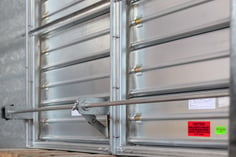Smoke control and fire dampers are important for fire safety in buildings. Regular maintenance by a competent company is crucial. In this blog, we will explain your responsibilities for maintaining and repairing these dampers.
Why fire and smoke control dampers are important
Fire dampers have been designed to help prevent the spread of fire and smoke throughout a building in the event of a fire. They are installed in a building's ductwork systems when it compromises a fire compartment wall.
In normal use, they are open to permit airflow and allow the flow of air around the building. However, if a fire was to break out, they would all automatically close when triggered by the smoke and fire alarms (or by fusible link operation). Therefore, they create a barrier to contain any flames and fumes that would otherwise have spread.
Smoke control dampers are specifically used for smoke control installations, they are not normally installed in HVAC ductwork and are not used for general ventilation purposes and so would normally stay closed the entire time.
In case of a fire, some dampers need to stay open while others need to be closed. The open dampers allow smoke and heat to be removed from the building through the smoke control system. The closed dampers act as a barrier to stop the fire and smoke from spreading to other areas of the building.
Damper maintenance: the regulations and your damper maintenance responsibilities
As smoke and fire dampers play such an important part in keeping buildings and their occupants safe, there are strict laws around how frequently they should be inspected, cleaned, tested and serviced. However, because they are almost always 'hidden' in ductwork systems their maintenance is often forgotten or neglected by the building owner or operator.
According to the Regulatory Reform (Fire Safety) Order 2005 England and Wales, it is the building owner or operator’s responsibility to maintain fire safety systems in their building - this includes smoke control and fire dampers. BS 9999 provides a best practice framework for fire safety and includes standards for damper maintenance and fire damper testing. It states that all fire dampers should meet the criteria of fire resistance for a stated period and that:
‘All fire dampers should be tested by a competent person at regular intervals not exceeding one year, and to be repaired or replaced immediately if found to be faulty. Spring-operated fire dampers should be tested annually and fire dampers situated in dust-laden and similar atmospheres should be tested much more frequently, at periods suited to the degree of pollution.’
To ensure you stay compliant and your buildings are properly protected in the event of a fire, we recommend that your fire and smoke control dampers are serviced at least once a year, are inspected at 6-monthly intervals and have 3-monthly functionality tests carried out by a competent servicer of fire and smoke control equipment.
Smoke damper maintenance: SFG20
SFG20, the definitive standard for planned maintenance, sets out the below best practice actions for smoke and fire damper maintenance.
For all fire and smoke dampers:
Visually inspect the fire damper’s internal components for signs of corrosion, dirt or dust. In line with the manufacturer’s instructions, clean and lubricate the damper and perform a drop test. Collect digital photographic evidence of damper condition prior to, during and after testing procedures.
For all electro-mechanical fire and smoke dampers:
Inspect latching mechanism, operating cable and remote controller (incl. indicator lamp). Ensure cleanliness of, damper guide channels, springs and around the units on completion. Check and ensure correct operation of shutter mechanism. Ensure free fall of damper(s). Check and ensure security of all access doors and gaskets. State possible sources of air leakage. Report any defects and record all actions undertaken.
Collect digital photographic evidence of damper condition prior to, during and after testing procedures.
For all air transfer fire and smoke dampers:
Inspect latching mechanism, operating cable and remote controller (incl. indicator lamp). Ensure cleanliness of damper guide channels, springs and around the units on completion. Check and ensure correct operation of shutter mechanism. Ensure free fall of damper(s). Check and ensure security of all access doors and gaskets. Check for air leaks.
Report any defects and record all actions undertaken.
Collect digital photographic evidence of damper condition prior to, during and after testing procedures.
Intumescent block fire dampers:
This type of damper can become blocked and impeded. They should therefore be part of the maintenance programme.
Thermal fuse and Intumescent air valves:
Remove and replace units in accordance with manufacturers guidance as required to allow cleaning and inspection.
Colt is the UK's no.1 smoke control maintenance provider and all our engineers are highly skilled and fully trained to deliver the best smoke control and fire damper maintenance. Colt is certified to both the IFCC SDI 05 and SDI 09 schemes in recognition of our competence as an installer and maintainer of smoke control systems – you are in safe hands with our engineers.
To talk to one of our experts about setting up a contract or to arrange a free site survey and quote, email us on service@uk.coltgroup.com or give us a call on 02392 491 735.
